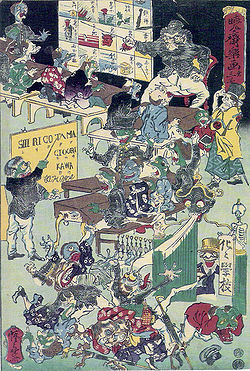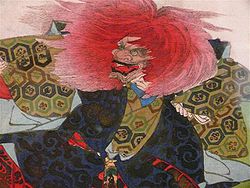
Kawanabe Kyosai
Encyclopedia

Japan
Japan is an island nation in East Asia. Located in the Pacific Ocean, it lies to the east of the Sea of Japan, China, North Korea, South Korea and Russia, stretching from the Sea of Okhotsk in the north to the East China Sea and Taiwan in the south...
ese artist, in the words of a critic, "an individualist and an independent, perhaps the last virtuoso in traditional Japanese painting".
Living through the Edo period
Edo period
The , or , is a division of Japanese history which was ruled by the shoguns of the Tokugawa family, running from 1603 to 1868. The political entity of this period was the Tokugawa shogunate....
to the Meiji period
Meiji period
The , also known as the Meiji era, is a Japanese era which extended from September 1868 through July 1912. This period represents the first half of the Empire of Japan.- Meiji Restoration and the emperor :...
, Kyōsai witnessed Japan transform itself from a feudal country into a modern state. Born at Koga
Koga, Ibaraki
is a city located in Ibaraki, Japan.-Old City of Koga:The city has its origins in the Tokugawa period when a castle was built in the 16th century at the river crossing point and a town sprang up around it. The site of the castle is still visible near Koga 1st elementary school. The modern city was...
, he was the son of a samurai
Samurai
is the term for the military nobility of pre-industrial Japan. According to translator William Scott Wilson: "In Chinese, the character 侍 was originally a verb meaning to wait upon or accompany a person in the upper ranks of society, and this is also true of the original term in Japanese, saburau...
. After working for a short time as a boy with Utagawa Kuniyoshi, he received his artistic training in the Kanō school
Kano school
The ' is one of the most famous schools of Japanese painting. The Kanō school of painting was the dominant style of painting until the Meiji period.It was founded by Kanō Masanobu , a contemporary of Sesshū and student of Shūbun...
, but soon abandoned the formal traditions for the greater freedom of the popular school. During the political ferment which produced and followed the revolution of 1867
Meiji Restoration
The , also known as the Meiji Ishin, Revolution, Reform or Renewal, was a chain of events that restored imperial rule to Japan in 1868...
, Kyōsai attained a reputation as a caricaturist
Caricature
A caricature is a portrait that exaggerates or distorts the essence of a person or thing to create an easily identifiable visual likeness. In literature, a caricature is a description of a person using exaggeration of some characteristics and oversimplification of others.Caricatures can be...
. He was arrested three times and imprisoned by the authorities of the shogunate. Soon after the assumption of effective power by the Emperor, a great congress of painters and men of letters was held at which Kyōsai was present. He again expressed his opinion of the new movement in a caricature, which had a great popular success, but also brought him into the hands of the police this time of the opposite party.
Kyōsai must be considered the greatest successor of Hokusai
Hokusai
was a Japanese artist, ukiyo-e painter and printmaker of the Edo period. He was influenced by such painters as Sesshu, and other styles of Chinese painting...
(of whom, however, he was not a pupil), and as the first political caricaturist of Japan. His work like his life is somewhat wild and undisciplined, and occasionally smacks of the sake cup. But if he did not possess Hokusai's dignity, power and reticence, he substituted an exuberant fancy, which always lends interest to draughtsmanship of very great technical excellence.

Folklore
Folklore consists of legends, music, oral history, proverbs, jokes, popular beliefs, fairy tales and customs that are the traditions of a culture, subculture, or group. It is also the set of practices through which those expressive genres are shared. The study of folklore is sometimes called...
of his country. A fine collection of these works is preserved in the British Museum
British Museum
The British Museum is a museum of human history and culture in London. Its collections, which number more than seven million objects, are amongst the largest and most comprehensive in the world and originate from all continents, illustrating and documenting the story of human culture from its...
; and there are also good examples in the National Art Library at South Kensington and the Guimet Museum
Guimet Museum
The Guimet Museum is a museum of Asian art located at 6, place d'Iéna in the 16th arrondissement of Paris, France...
at Paris
Paris
Paris is the capital and largest city in France, situated on the river Seine, in northern France, at the heart of the Île-de-France region...
. The Kawanabe Kyōsai Memorial Museum was established in 1977, located at Warabi
Warabi, Saitama
is a city located in Saitama, Japan. Warabi is the name of a bracken. The city was founded on April 1, 1959.As of 2003, the city has an estimated population of 71,034 and a density of 13,928.24 persons per km². The total area is 5.10 km²...
, Saitama Prefecture
Saitama Prefecture
is a prefecture of Japan located in the Kantō region of the island of Honshu. The capital is the city of Saitama.This prefecture is part of the Greater Tokyo Area, and most of Saitama's cities can be described as suburbs of Tokyo, to which a large amount of residents commute each day.- History...
, Japan.

